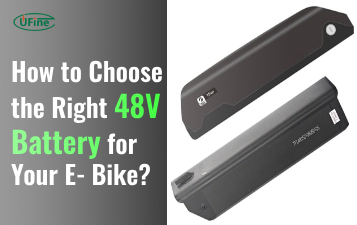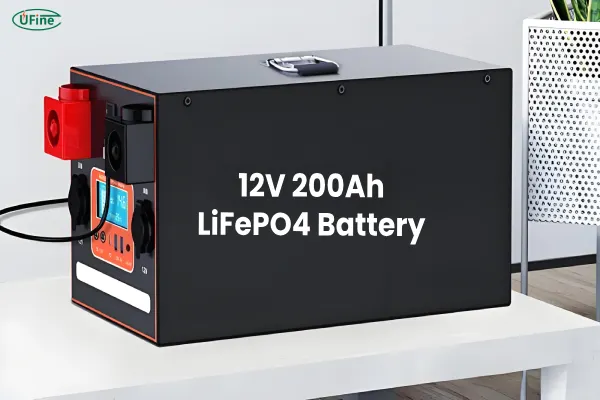Part 1. Understanding the 12V 200Ah LiFePO4 battery
A 12V 200Ah LiFePO4 battery is a popular choice for a variety of applications due to its high energy density and reliable performance.
Key Specifications:
- Nominal Voltage: 12V (Lithium-ion standard)
- Capacity: 200Ah (Ampere-hours), which indicates how much current a battery can provide over a certain period of time.
- Size: Typically, the dimensions of this battery can range from 300mm (length) x 200mm (width) x 220mm (height), depending on the manufacturer and specific design.
- Weight: Approximately 20-25 kg (44-55 lbs), making it relatively lightweight compared to other battery chemistries like lead-acid.
Typical Applications:
- Solar energy storage
- RV and boat power systems
- Electric vehicles (EVs)
- Backup power supply
The 12V 200Ah LiFePO4 battery is known for its compact size and long-lasting capacity, providing stable voltage and high performance in various energy-intensive systems.
Part 2. Temperature performance
One of the standout features of LiFePO4 batteries is their robust temperature tolerance.
- Operational Temperature: LiFePO4 batteries can typically function well in temperatures ranging from -20°C to 60°C (-4°F to 140°F).
- Charging Temperature: Ideal charging temperatures range from 0°C to 45°C (32°F to 113°F). Charging below freezing can harm the battery’s internal structure and reduce overall efficiency.
- Discharge Performance: LiFePO4 batteries maintain stable voltage and performance across a wide temperature range, offering better cold-weather performance than many other lithium-ion chemistries.
Ufine Battery designs and manufactures batteries that operate efficiently even in extreme temperatures, making them perfect for high-demand environments such as solar power systems in colder climates or RV systems in hotter regions. Contact us now!
What Effect Does Low Temperature Have on Lithium Batteries?
Part 3. Safety protection
The 12V 200Ah LiFePO4 battery comes equipped with several built-in safety mechanisms:
- Overcharge Protection: Prevents the battery from being charged above its rated voltage, which could lead to thermal runaway or reduced lifespan.
- Over-discharge Protection: Protects the battery from deep discharge, which can cause permanent damage to the cells.
- Short-circuit Protection: Safeguards against high currents that may cause the battery to overheat or malfunction.
- Temperature Monitoring: Ensures the battery operates within safe temperature ranges, preventing overheating or freezing damage.
These protections enhance the reliability and safety of the battery, especially when used in remote or off-grid applications where maintenance and monitoring are limited.
Part 4. Charger compatibility
Charging a 12V 200Ah LiFePO4 battery requires a charger that is designed specifically for lithium-ion batteries.
- Charging Voltage: The battery typically charges up to 14.6V for full charge.
- Recommended Charger: A 12V lithium battery charger with a current rating that is suitable for the battery’s capacity is crucial. For a 200Ah battery, a 10-20A charger would be ideal to ensure a balance between charge time and battery health.
- Charging Time: Using a charger rated for 10A could charge the battery in approximately 20 hours. A higher-rated charger will reduce charging time but can affect the battery lifespan if used too aggressively.
Part 5. Energy output: How many hours will it power devices?
With a 12V 200Ah LiFePO4 battery, you have 2,400 Wh of energy. But how long will it last powering different devices?
Here are a few examples:
12V LED lights (30W):
2,400Wh ÷ 30W = 80 hours of continuous use.
12V Refrigerator (150W):
2,400Wh ÷ 150W = 16 hours of continuous use.
12V TV (100W):
2,400Wh ÷ 100W = 24 hours of continuous use.
As you can see, the 12V 200Ah LiFePO4 battery can power a variety of devices for a substantial amount of time. Keep in mind that the actual duration will depend on the efficiency and power usage of each device.
Part 6. Cycle life of the 12V 200Ah LiFePO4 battery
The LiFePO4 battery is renowned for its long cycle life, making it a preferred choice for high-demand applications.
- Average Cycle Life: The 12V 200Ah LiFePO4 battery typically lasts for 2,000 to 5,000 cycles, depending on usage patterns (e.g., depth of discharge or charge cycles).
- Calendar Life: Even after many cycles, these batteries can last up to 10 years with proper maintenance.
- End of Life: After about 2,000 to 3,000 cycles, the battery capacity will decline to around 70%-80% of its original capacity.
In contrast to lead-acid batteries, which typically offer 500 to 1,000 cycles, LiFePO4 batteries provide significantly longer operational lifespans.
Part 7. How to calculate the lifespan of a 12V 200Ah LiFePO4 battery
To estimate the lifespan of a 12V 200Ah LiFePO4 battery, consider the following factors:
Depth of Discharge (DoD): The greater the DoD, the fewer the cycles. If you routinely discharge the battery to 20% of its total capacity, it will last longer than if you fully discharge it every time.
- If you discharge the battery to 50% (50% DoD), the battery can last up to 4,000 cycles.
- Discharging to 80% can reduce the cycle life to around 2,000 cycles.
Charging and Discharging Patterns: Frequent partial charges and discharges tend to be healthier for the battery compared to full charge and deep discharge cycles.
Formula:
Battery Life (in years) = (Number of cycles) / (365 cycles per year)
Example:
If the battery is expected to last 2,000 cycles with 50% DoD, it would last for about 5.5 years.
Part 8. Signs that the 12V 200Ah LiFePO4 battery needs replacement
Here are some common signs that the 12V 200Ah LiFePO4 battery may be nearing the end of its useful life:
- Significant Capacity Loss: If the battery no longer holds a charge or provides much less energy than it originally did, it may need replacing.
- Slow Charging Times: If the charging time becomes significantly longer, this could be an indicator of reduced efficiency or aging cells.
- Increased Temperature During Use: Excessive heat generation during use could point to internal degradation.
- Voltage Drops: Frequent voltage drops below the nominal range while under load could indicate reduced cell health.
Part 9. Factors affecting the lifespan of a 12V 200Ah LiFePO4 battery
Several factors contribute to the longevity of your 12V 200Ah LiFePO4 battery:
- Temperature: High temperatures can degrade battery chemistry. Keeping the battery in cool, controlled environments will help maximize its lifespan.
- Depth of Discharge (DoD): As mentioned earlier, a higher DoD reduces cycle life. Ideally, avoid discharging below 20%-30% of the battery’s total capacity.
- Charging Habits: Overcharging or undercharging the battery can accelerate wear. Always use the correct charger and monitor charge levels to prevent damage.
- Maintenance: Regular maintenance and care, such as cleaning terminals and monitoring for faults, can extend battery life.
Part 10. How to extend the lifespan of a 12V 200Ah LiFePO4 battery?
Here are several tips to prolong the life of your 12V 200Ah LiFePO4 battery:
- Charge Regularly: Keeping your battery regularly charged within the optimal range (20%-80% DoD) will prevent premature wear.
- Avoid Overheating: Ensure the battery is stored and used in cool environments to avoid excessive temperature-related degradation.
- Use a Proper Charger: Always use a charger specifically designed for LiFePO4 batteries to ensure efficient and safe charging.
- Monitor Battery Health: Using a Battery Management System (BMS) can help monitor key parameters like voltage, current, and temperature, ensuring the battery remains within safe operating conditions.
Part 11. Common issues
- Overheating: Can occur due to overcharging or improper ventilation.
- Capacity Fade: Over time, the battery may gradually lose its capacity.
- Faulty BMS: Malfunctions in the Battery Management System can lead to improper charging or discharging.
- Loose Connections: Poor connections can lead to voltage drops or inefficiencies.
Part 12. Maintenance and care
To ensure long-term performance and health of your 12V 200Ah LiFePO4 battery, perform regular maintenance:
- Check Voltage Regularly: Ensure the battery is operating within the optimal voltage range.
- Clean Battery Terminals: Dust and corrosion can lead to poor connections.
- Monitor Temperature: Ensure the battery is kept in an environment where temperature extremes are avoided.
Ufine Battery offers customized solutions for your 12V LiFePO4 battery needs. If you’re looking for a high-performance, long-lasting battery solution, feel free to contact us for your specific requirements.
Related Tags:
More Articles

How to Choose the Right 48V Battery for Your E‑Bike?
Choosing the right 48V e-bike battery depends on motor size, usage, chemistry, and safety—this guide helps you make the best decision.
Aluminum Air Battery vs. Lithium‑Ion: Key Cost & Performance Differences
Aluminum air vs lithium-ion: non-rechargeable but high energy density vs. rechargeable and widely used in EVs, electronics, and storage systems.
Aluminum Air Battery Design: Materials, Assembly & Efficiency Tips
An aluminum air battery uses aluminum and air to generate power. Learn its materials, assembly steps, and tips to boost energy output and efficiency.
7 Advantages of a Heated Lithium Battery in Cold Climates
Looking to power batteries in freezing temps? Heated lithium batteries excel in cold climates. Here are 7 key benefits and how they work.
How to Choose the Best Floor Scrubber Battery for Commercial Cleaning?
Selecting the ideal floor scrubber battery ensures a long runtime, rapid charging, and minimal maintenance for efficient commercial cleaning operations.




